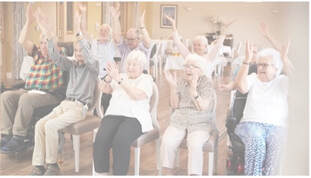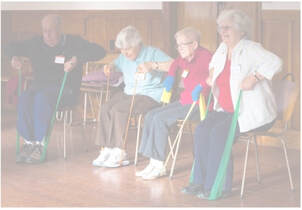|
Exercise in Nursing Homes How to design an exercise programme for nursing home residents Dr Phil Handorf, Dip T, Bed PhD. Phil is head of the Centre for Physical Activity in Ageing, Hampstead Rehabilitation Centre Adelaide and Chief Exercise Physiologist, Department of Geriatric and Rehabilitation Medicine, Royal Adelaide Hospital  There is no doubt that physical activity is a sound pursuit for nursing home residents, but the difficulty lies in implementing suitable programmes for this population group. While the contradictions to exercise are no different to those applying to younger people, specific changes in programme design must be made in order to accommodate individual disabilities and limitations. Contrary to popular belief, physical activity for the very old can be undertaken safely, despite the presence of a host of medical conditions. For example, diabetes, chronic renal failure, stroke, cardiac disease, arthritis, depression, osteoporosis or dementia (which all may be evident in the same person) are not in themselves contraindications to physical activity. Exercise may in fact offer benefits not easily achievable through traditional pharmalogical treatments. There are, however, certain changes in normal functions that necessitate a medical examination prior to the commencement of any new physical activity. These include acute fever, chest discomfort, musculoskeletal pain, uncontrolled diabetes, high blood pressure, sudden weight loss or a recent fall. It is also important that when you design a programme for nursing home residents, the goals you set for the programme for are specifically tailored to the needs of the participants. Suitable goals for this population group include:
To date the most beneficial physical activity programmes for older people appear to encompass progressive resistance training (involving major muscle groups of the upper and lower limbs and trunk) performed at a relatively high intensity. Given the reduced physical capacity of nursing home residents, strengthening programmes should encompass simple rather than complex tasks. These may include chair-based and chair assisted exercise; water walking; range of motion activities; resistance band exercises for upper and lower limbs; breathing and relaxation activities; and simple hand function actions. Balance training is of considerable significance and should be incorporated into any physical activity programme for older people. The emphasis should be on dynamic movements that challenge the centre of gravity and activities that govern muscle groups involved in upright posture. Balance training should also be structured to progressively include more difficult postures (ie by decreasing the base of support) as the ability of the participant improves. Some examples of good balance exercises (to be performed in the standing position, holding a chair or other support) include: feet shoulder width apart, extend arms slightly forward, raise both heels off the ground and hold for 10 seconds without the need for support, transfer body weight from one leg to another. Cardio respiratory training (to improve aerobic capacity) may well be either inappropriate or unachievable among certain nursing home residents. As such, this form of physical activity should not take precedence over strength and balance work. Upon implementation, however, a frequency of at least three sessions per week involving up to 20 minutes duration (at between 40% to 60% of heart rate reserve) is recommended. Indeed, the duration of exercise has received greater attention recently and it is now recommended that far shorter periods of activity (even as low as two to three minutes) may have a beneficial effect. Older adults can perform numerous exercises; however, as with younger individuals, there are several movements that are contraindicated. These include: deep knee bends; toe touching with straight legs (standing); extreme extension of the lower back; jerking and sudden movements; breath holding; static or isometric exercises (unless specifically prescribed by a health professional); and full circle movements of the head, neck, trunk, ankles or wrists. Many older people are hesitant about floor-based exercises and for some getting up off the floor is not practicable. For many, however, floor work is quite achievable (provided adequate matting is used) and once the client has undergone some simple instructions about lowering to and rising from the floor, many exercises can be performed in this position. Clearly, however, additional stand up assistance may be required depending upon individual needs. Of course, the golden rule remains that any exercise that leads to pain or discomfort should be completely avoided. Functional exercises Functional fitness relates to an individual’s ability to perform the activities of daily living, and it should influence the objectives and programming of physical activity for older people. As such, exercise should (if possible) reflect day-to-day activities. Some examples include: partial neck rotations, upper body movements such as lifting, reaching, turning and pushing (eg chair dips); stair climbing movements such as stepping up and down off multi-levelled platforms (performed while seated in a chair); sit to stand to sit movements; and lower limb exercise such as heel raise and squats performed holding onto the back of a chair). Warm up and cool down An adequate warm up should be an important part of your programme. Up to 10 or 15 minutes should be spent on the warm up phase, depending upon the functional capacity of your clients. This time is critical to ensure a gradual increase in circulation and heart rate. All joints should be engaged in the warm up. The cool down section is just as important and a similar amount of time should be spent in this segment of the programme.  Chair based exercises Chair based exercise plays an important role in physical activity programmes for the very old. Indeed, many chair-based exercises may also be adapted for use where the client is confined to bed. Chairs without arms provide some benefits in regard to support for the upper limbs. Having a chair that supports the back is important, as is the requirement for the client’s feet to be in touch with either the floor or another hard surface (eg telephone book). The chair provides support for standing balance work and strengthening activities including exercise bands, ankle weight and dumbbells. Strength training Current guidelines for strength training include:
However, for instructors working with de-conditioned or frail people a more simplistic guide to strengthening exercise is as follows:
Importantly The initial resistance should always be specifically tailored to meet the needs of the individual and in some circumstances will involve extremely light resistances. Conclusion Participation in a physical activity programme is both a feasible and desirable pursuit for nursing home residents. Of course, the benefit of exercise training matters little if the client does not take some pleasure from participating in the programme. Enhanced compliance to physical activity is more likely to be achieved if the programme meets the social needs of your clients, rather than merely improving muscle strength or aerobic capacity. Comments are closed.
|
AuthorShonagh O'Hagan Archives
July 2024
|

 RSS Feed
RSS Feed